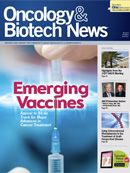Publication
Article
Oncology & Biotech News
Iloprost Causes Regression of Endobronchial Dysplasia in Former Smokers
Author(s):
Results of a phase II trial showed that former smokers had significant regression of endobronchial dysplasia when treated with iloprost.

Results of a phase II trial showed that former smokers had significant regression of endobronchial dysplasia, a condition involving abnormal cell development that can lead to lung cancer, when treated with iloprost, an oral prostacyclin analogue. The dysplasia index declined by more than 50% after 6 months of treatment. The average score for all endobronchial biopsies and for the biopsy with the worst score improved by 35% to 40%.
In contrast, current smokers had no significant changes in any of the outcomes after 6 months of treatment with iloprost, said Paul Bunn, MD, at the AACR meeting.
“As expected, current smokers had higher scores at baseline than former smokers,” said Bunn, a professor of medicine at the University of Colorado in Denver, during an AACR press briefing. “The histologic improvements in iloprost-treated former smokers were larger in magnitude than the difference between current and former smokers.”
The study grew out of the recognition that former smokers account for half of all new cases of lung cancer. Quitting, by itself, would not reduce an ex-smoker’s risk of lung cancer, said Bunn. That knowledge left lung cancer researchers with a conundrum: what can be done to help former smokers reduce their risk of lung cancer?

Paul Bunn, MD
"The histologic improvements in iloprost-treated former smokers were larger in magnitude than the difference between current and former smokers."
—Paul Bunn, MD
For an answer, investigators turned to iloprost, which has demonstrated an ability to prevent lung cancer in preclinical models, including a model of exposure to cigarette smoke. Bunn reported findings from a study involving 152 participants, consisting of 75 former smokers and 77 current smokers. Participants in both groups had a smoking history of at least 20 pack-years. They were randomized to placebo or to an escalating dose of iloprost, beginning with 50 μg twice a day and increasing to 150 μg twice a day.
All participants had endobronchial biopsies before starting treatment and again after 6 months. The primary endpoint was the change in average histology score at the second biopsy. Former smokers treated with iloprost had a decline in average biopsy score from 3.3 at baseline to 2.1 after 6 months, a decline in worst biopsy score from 4.6 at baseline to 3.1, and a decline in dysplasia index from 43% to 19.6%. Iloprost did not significantly affect any of the outcome scores in current smokers and study participants randomized to placebo had no improvement.

Daniel Von Hoff, MD
Bunn pointed out that another way of gauging the effect of iloprost in former smokers would be to compare baseline differences between the current and former smokers with the 6-month changes in the former smokers. At baseline, current smokers’ average biopsy score was 0.5 higher than that of former smokers, the worst biopsy score was 0.4 higher, and the dysplasia index was 15% higher. The magnitude of the changes in former smokers from baseline to 6 months with iloprost was greater than the baseline differences for all 3 measures. The key secondary endpoint was the change from baseline to 6 months in levels of the Ki-67 proliferation factor. Iloprost had no impact on levels of that biomarker.
Despite the encouraging results, iloprost could face an uphill battle to prove its mettle in a large phase III trial, said Daniel Von Hoff, MD, a professor of medicine at Mayo Clinic in Scottsdale, Arizona, and moderator of the press conference. Iloprost will go off patent in the near future, so the manufacturer will have little incentive to sponsor a phase III program. Unless the National Cancer Institute picks up the tab, the necessary trials might never come to pass.









